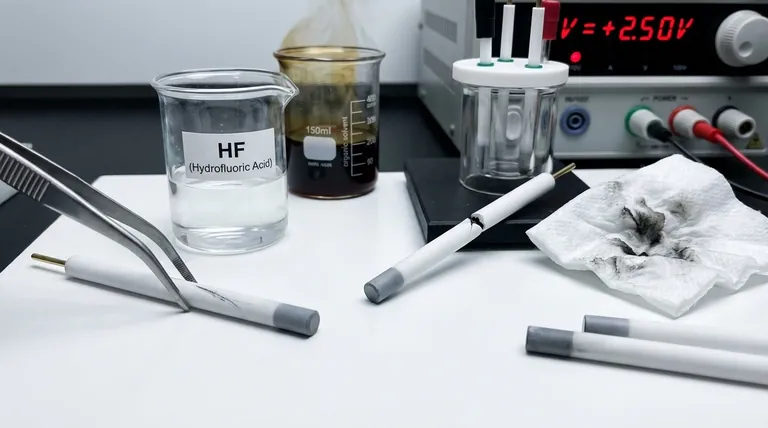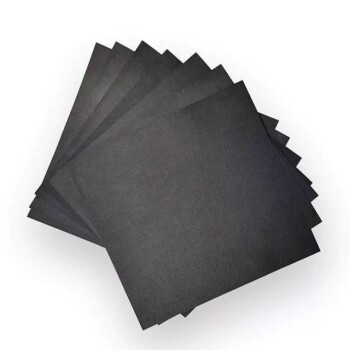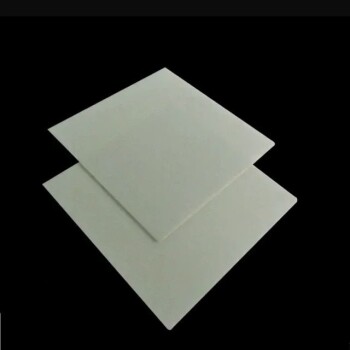To ensure its integrity, a glassy carbon sheet must be protected from specific physical, chemical, and electrical damage. You are strictly prohibited from scratching the surface with metal tools, exposing it to solutions containing fluoride ions (like hydrofluoric acid), applying an anodic polarization greater than +2.0V, or allowing contact with corrosive organic solvents. These actions can cause irreversible damage to the material's structure and performance.
Glassy carbon is a powerful tool known for its chemical inertness and electrochemical stability, but it is also physically brittle and sensitive to specific operational extremes. Protecting its unique surface structure is the single most important factor in ensuring its longevity and the reliability of your results.

Understanding Mechanical Fragility
While chemically robust, glassy carbon is physically brittle, much like the glass it is named after. Mishandling is the most common cause of premature failure.
Avoid Scratches and Abrasions
Do not use metal tools, such as tweezers or spatulas, to handle or clean the sheet. These can easily create deep scratches on the surface, altering its electrochemical properties and creating sites for contamination.
Prevent Cracks from Bending or Squeezing
The material has low tolerance for mechanical stress. Avoid excessive bending, squeezing, or sudden impacts and collisions, as these can cause the sheet to fracture.
Use Proper Clamping Techniques
When installing the sheet, use a non-damaging clamp, such as one made of PTFE (Teflon). The applied torque must not exceed 0.5 N·M to prevent stress-induced cracking at the mounting point.
Preventing Chemical and Electrochemical Damage
The performance of glassy carbon is directly tied to its pristine surface. Exposure to certain chemicals or exceeding its electrical limits will permanently compromise it.
Steer Clear of Fluoride Ions
Do not use the sheet in any solution containing fluoride ions (F⁻). This includes hydrofluoric acid (HF) and other fluoride salts, which will chemically attack and etch the carbon surface.
Avoid Irreversible Oxidation
Never apply an anodic polarization that exceeds +2.0V. Voltages above this threshold will cause irreversible oxidation of the carbon surface, permanently altering its electrochemical behavior and rendering it unusable for many applications.
Limit Exposure to Aggressive Solvents and Solutions
Avoid all contact with organic solvents that may corrode or dissolve the surface. Similarly, do not immerse the sheet in strong acid or strong alkali solutions for extended periods, as this can degrade the material over time.
Maintaining Operational Integrity
Consistent and reliable results depend on operating the glassy carbon sheet within its specified limits and maintaining a clean environment.
Control Contamination Sources
Your experimental environment must be kept clean. Avoid contamination from airborne organic substances and metal compounds, which can adsorb onto the surface and interfere with electrochemical measurements.
Prevent Overheating and Thermal Shock
The sheet should not come into contact with high-temperature sources. Overheating can damage the material's structure and compromise its integrity.
Adhere to Electrical Limits
Always operate within the specified current and voltage ranges for your particular sheet. Exceeding these limits can cause damage analogous to blowing a fuse in an electronic circuit.
Ensure Precise Surface Area
For quantitative electrochemical work, the exposed surface area of the sheet must be precisely known and controlled. An error of less than 3% is required to ensure the accuracy of your measurements.
A Practical Checklist for Reliable Performance
Use these guidelines to ensure you get the most out of your glassy carbon sheet.
- If your primary focus is accurate measurement: Prioritize maintaining a pristine, uncontaminated surface and ensuring the exposed geometric area is precisely controlled.
- If your primary focus is long-term durability: Focus on preventing mechanical stress, avoiding all contact with fluoride, and never exceeding the +2.0V anodic limit.
- If your primary focus is safety and consistency: Strictly adhere to the manufacturer's specified current, voltage, and thermal limits during every experiment.
Treating your glassy carbon sheet with meticulous care is the key to unlocking repeatable, high-quality data.
Summary Table:
| Prohibition Category | Strictly Prohibited Actions | Key Limit / Hazard |
|---|---|---|
| Mechanical | Scratching with metal tools, bending, squeezing | Torque > 0.5 N·M; risk of cracking |
| Chemical | Exposure to fluoride ions (HF, F⁻ salts), corrosive solvents | Chemical etching and surface degradation |
| Electrochemical | Applying anodic polarization > +2.0V | Irreversible oxidation of the carbon surface |
| Operational | Exceeding current/voltage limits, overheating, contamination | Measurement inaccuracy, structural damage |
Maximize the performance and lifespan of your lab equipment.
Glassy carbon sheets are a critical component for precise electrochemical measurements. Proper handling is non-negotiable for data integrity. KINTEK specializes in high-quality lab equipment and consumables, providing the reliable tools and expert support your laboratory needs to operate successfully and safely.
Ensure your experiments are built on a foundation of quality and precision. Contact our experts today to find the perfect glassy carbon solution for your application and get the support you deserve.
Visual Guide

Related Products
- Glassy Carbon Electrochemical Electrode
- Glassy Carbon Sheet RVC for Electrochemical Experiments
- Hydrophilic Carbon Paper TGPH060 for Battery Lab Applications
- Silicon Carbide (SIC) Ceramic Sheet Wear-Resistant Engineering Advanced Fine Ceramics
- Platinum Sheet Electrode for Laboratory and Industrial Applications
People Also Ask
- How should a glassy carbon electrode be polished? A Step-by-Step Guide to a Perfect Electrochemical Surface
- What are the common shapes and sizes of glassy carbon electrodes? Key Specs for Reproducible Results
- What is the typical working electrode potential range for a glassy carbon electrode in aqueous electrolytes? A Guide to Accurate Electrochemical Measurements
- What are the pre-treatment steps for a glassy carbon electrode before use? Ensure Reliable Electrochemical Data
- How to make a glassy carbon electrode? A Guide to the Industrial Pyrolysis Process



















